Abstract
Insulin molecules were covalently attached to detergent-solubilized Sendai virus envelope glycoproteins (HN and F polypeptides) by the use of the crosslinking reagent succinimidyl 4-(p-maleimidophenyl)butyrate (SMPB). Reconstitution of modified viral glycoproteins (carrying covalently attached insulin) together with unmodified viral glycoproteins resulted in the formation of "fusogenic" viral envelopes bearing insulin molecules. Reconstitution of such fusogenic viral envelopes in the presence of ricin A or simian virus 40 (SV40) DNA resulted in the formation of viral envelopes bearing insulin molecules and loaded with ricin A or SV40 DNA. Such viral envelopes were able to bind to hepatoma tissue culture cells (HTCC) from which Sendai virus receptors were removed by treatment with neuraminidase. Incubation of viral envelopes loaded with ricin A with virus receptor-depleted HTCC resulted in fusion-mediated injection of the toxin, as inferred from inhibition of protein synthesis and decrease in cell viability of the microinjected cells. Fusion-mediated injection of SV40 DNA was inferred from the appearance of SV40 tumor antigen in microinjected cells. Binding and fusion of the loaded viral envelopes to neuraminidase-treated HTCC was mediated solely by the virus-associated insulin molecules. Addition of free insulin molecules inhibited binding of the viral envelopes and, consequently, the microinjection of ricin A and SV40 DNA.
Full text
PDF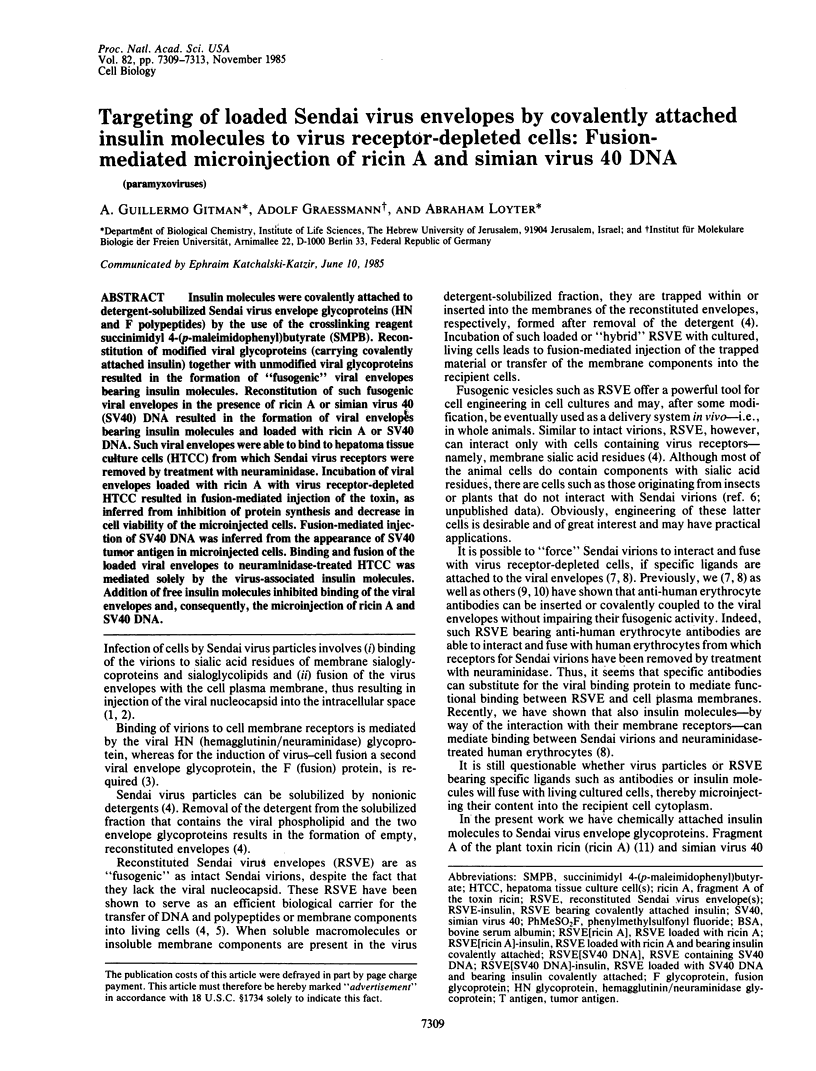
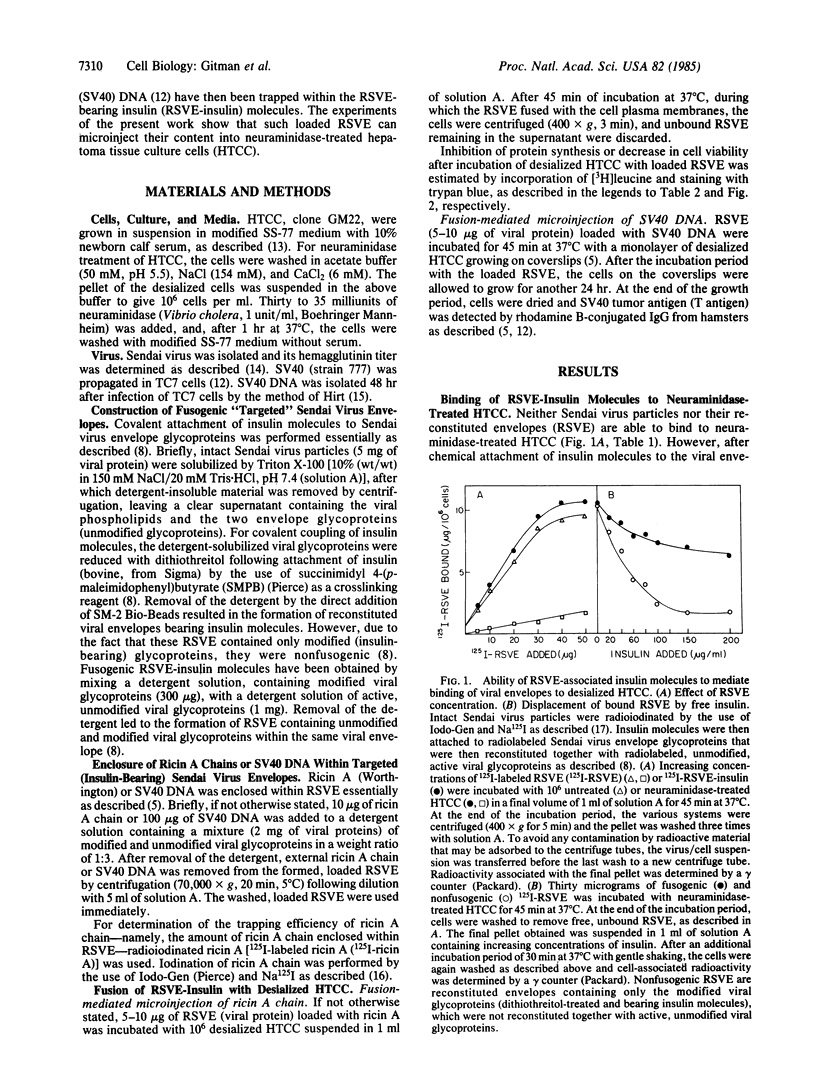
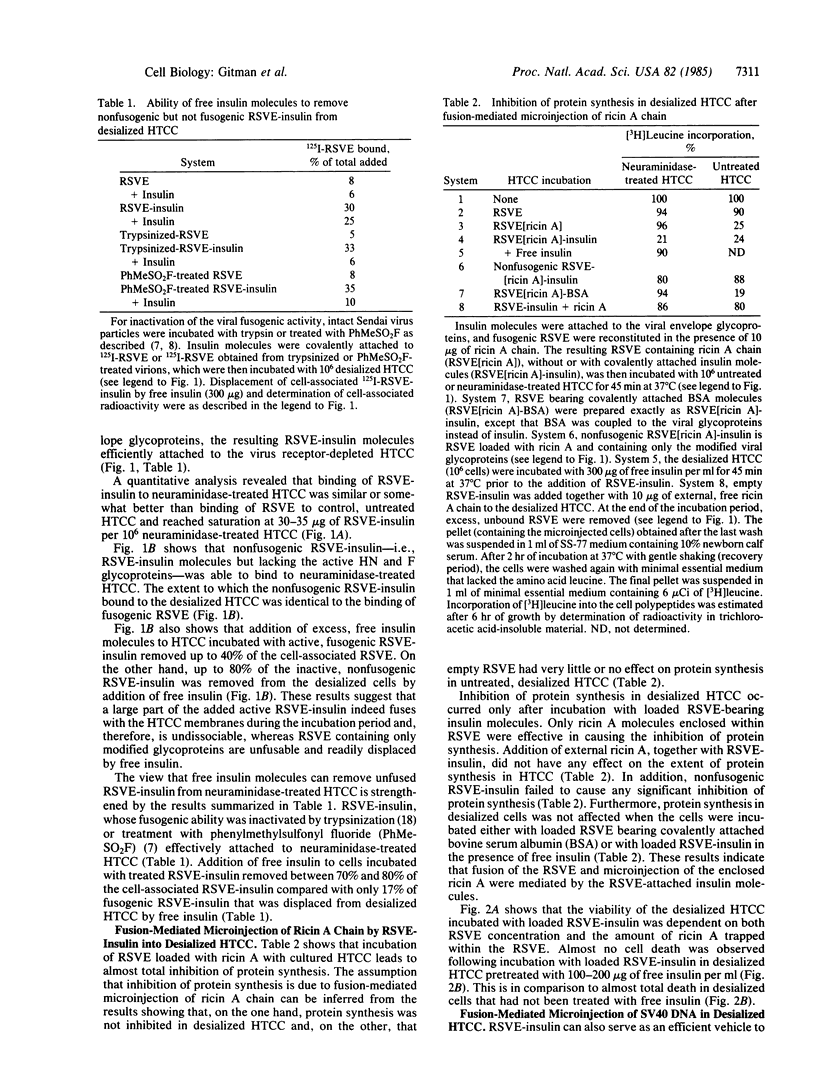
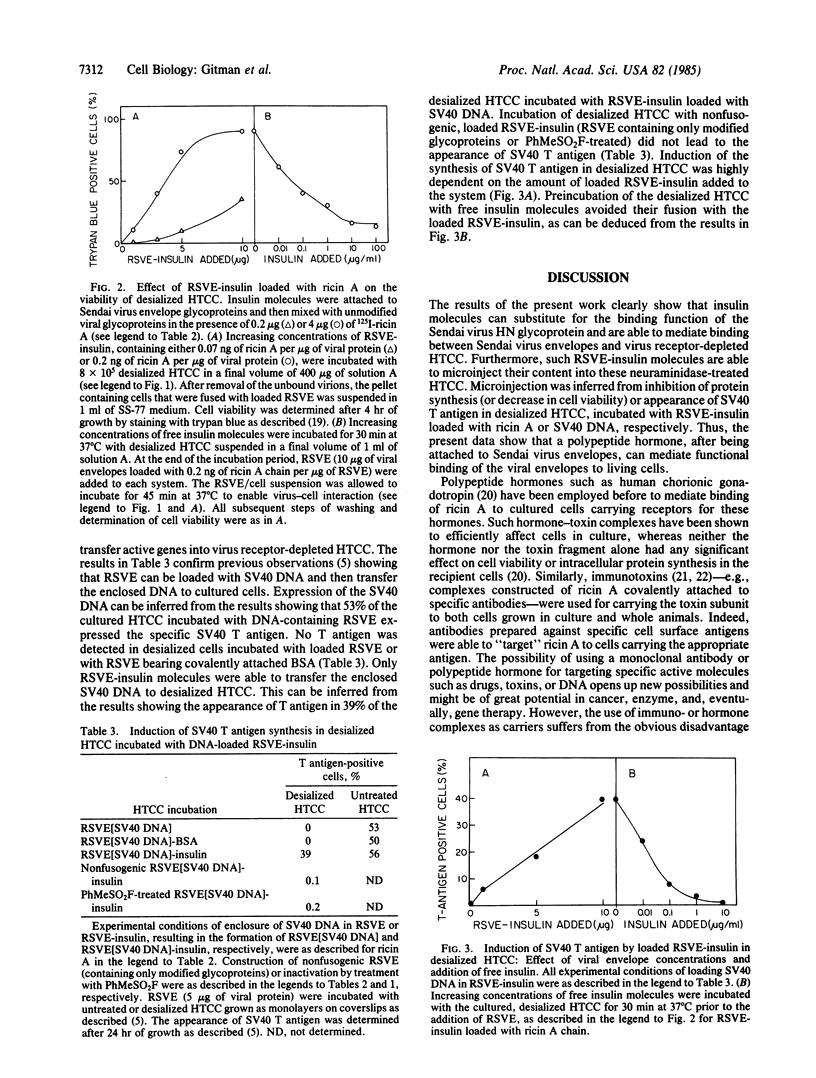
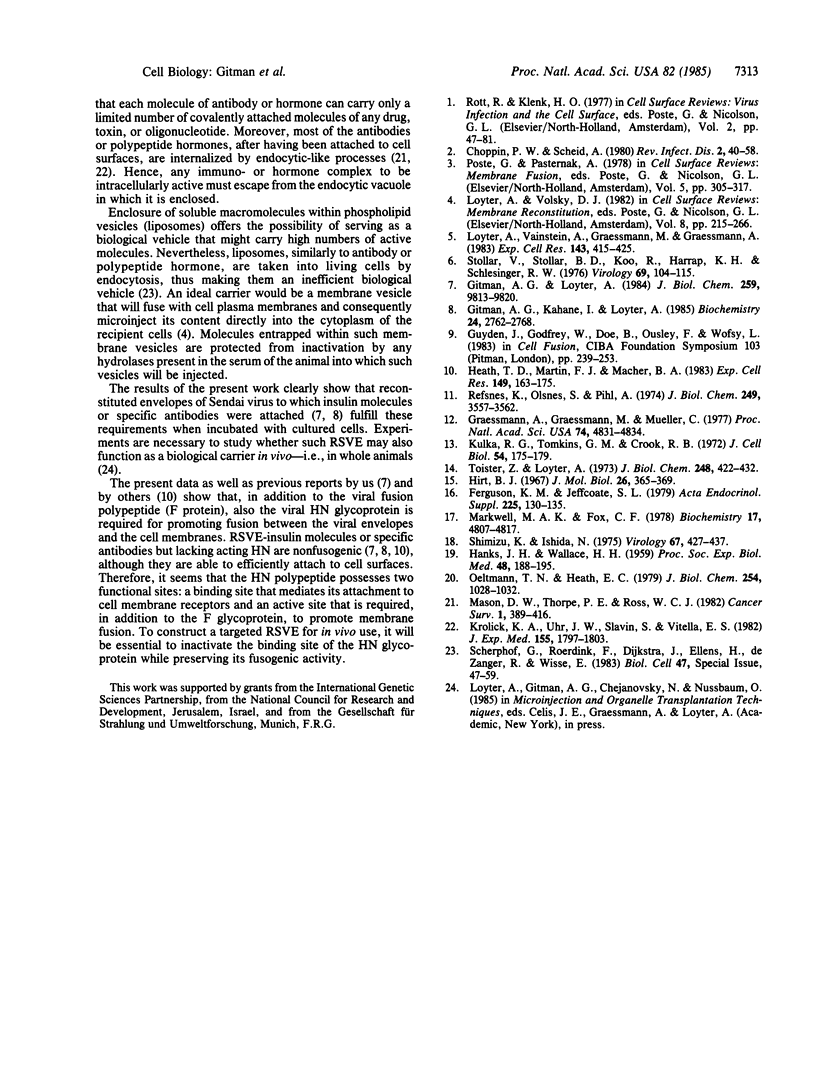
Selected References
These references are in PubMed. This may not be the complete list of references from this article.
- Choppin P. W., Scheid A. The role of viral glycoproteins in adsorption, penetration, and pathogenicity of viruses. Rev Infect Dis. 1980 Jan-Feb;2(1):40–61. doi: 10.1093/clinids/2.1.40. [DOI] [PubMed] [Google Scholar]
- Gitman A. G., Kahane I., Loyter A. Use of virus-attached antibodies or insulin molecules to mediate fusion between Sendai virus envelopes and neuraminidase-treated cells. Biochemistry. 1985 May 21;24(11):2762–2768. doi: 10.1021/bi00332a025. [DOI] [PubMed] [Google Scholar]
- Gitman A. G., Loyter A. Construction of fusogenic vesicles bearing specific antibodies. Targeting of reconstituted Sendai virus envelopes towards neuraminidase-treated human erythrocytes. J Biol Chem. 1984 Aug 10;259(15):9813–9820. [PubMed] [Google Scholar]
- Graessmann A., Graessmann M., Mueller C. Regulatory function of simian virus 40 DNA replication for late viral gene expression. Proc Natl Acad Sci U S A. 1977 Nov;74(11):4831–4834. doi: 10.1073/pnas.74.11.4831. [DOI] [PMC free article] [PubMed] [Google Scholar]
- Guyden J., Godfrey W., Doe B., Ousley F., Wofsy L. Immunospecific vesicle targeting facilitates fusion with selected cell populations. Ciba Found Symp. 1984;103:239–253. doi: 10.1002/9780470720844.ch15. [DOI] [PubMed] [Google Scholar]
- Heath T. D., Martin F. J., Macher B. A. Association of ganglioside-protein conjugates into cell and Sendai virus. Requirement for the HN subunit in viral fusion. Exp Cell Res. 1983 Nov;149(1):163–175. doi: 10.1016/0014-4827(83)90389-0. [DOI] [PubMed] [Google Scholar]
- Hirt B. Selective extraction of polyoma DNA from infected mouse cell cultures. J Mol Biol. 1967 Jun 14;26(2):365–369. doi: 10.1016/0022-2836(67)90307-5. [DOI] [PubMed] [Google Scholar]
- Krolick K. A., Uhr J. W., Slavin S., Vitetta E. S. In vivo therapy of a murine B cell tumor (BCL1) using antibody-ricin A chain immunotoxins. J Exp Med. 1982 Jun 1;155(6):1797–1809. doi: 10.1084/jem.155.6.1797. [DOI] [PMC free article] [PubMed] [Google Scholar]
- Kulka R. G., Tokins G. M., Crook R. B. Clonal differences in glutamine synthetase activity of hepatoma cells. Effects of glutamine and dexamethasone. J Cell Biol. 1972 Jul;54(1):175–179. doi: 10.1083/jcb.54.1.175. [DOI] [PMC free article] [PubMed] [Google Scholar]
- Loyter A., Vainstein A., Graessmann M., Graessmann A. Fusion-mediated injection of SV40-DNA. Introduction of SV40-DNA into tissue culture cells by the use of DNA-loaded reconstituted Sendai virus envelopes. Exp Cell Res. 1983 Feb;143(2):415–425. doi: 10.1016/0014-4827(83)90068-x. [DOI] [PubMed] [Google Scholar]
- Markwell M. A., Fox C. F. Surface-specific iodination of membrane proteins of viruses and eucaryotic cells using 1,3,4,6-tetrachloro-3alpha,6alpha-diphenylglycoluril. Biochemistry. 1978 Oct 31;17(22):4807–4817. doi: 10.1021/bi00615a031. [DOI] [PubMed] [Google Scholar]
- Oeltmann T. N., Heath E. C. A hybrid protein containing the toxic subunit of ricin and the cell-specific subunit of human chorionic gonadotropin. II. Biologic properties. J Biol Chem. 1979 Feb 25;254(4):1028–1032. [PubMed] [Google Scholar]
- Refsnes K., Olsnes S., Pihl A. On the toxic proteins abrin and ricin. Studies of their binding to and entry into Ehrlich ascites cells. J Biol Chem. 1974 Jun 10;249(11):3557–3562. [PubMed] [Google Scholar]
- Shimizu K., Isida N. The smallest protein of Sendi virus: its candidate function of binding nucleocaspsid to envelope. Virology. 1975 Oct;67(2):427–437. [PubMed] [Google Scholar]
- Stollar V., Stollar B. D., Koo R., Harrap K. A., Schlesinger R. W. Sialic acid contents of sindbis virus from vertebrate and mosquito cells. Equivalence of biological and immunological viral properties. Virology. 1976 Jan;69(1):104–115. doi: 10.1016/0042-6822(76)90198-7. [DOI] [PubMed] [Google Scholar]
- Toister Z., Loyter A. The mechanism of cell fusion. II. Formation of chicken erythrocyte polykaryons. J Biol Chem. 1973 Jan 25;248(2):422–432. [PubMed] [Google Scholar]


